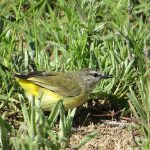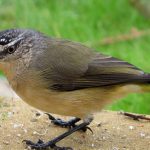YELLOW-RUMPED THORNBILL
The Yellow-rumped Thornbill is known for its distinctive yellow rump and a rather plain brownish-grey plumage. They are quite small birds, with an average length of around 10-12 cm and a wingspan of about 15-20 cm.
Found throughout most of mainland Australia, they inhabit a wide range of environments, including woodlands, heathlands, mallee, and open forests. They are well adapted to both arid and semi-arid regions, making them a versatile species.
These birds primarily feed on insects and their larvae, spiders, and occasionally nectar. They forage on the ground and in shrubs, searching for their prey among leaves and bark.
Yellow-rumped Thornbills are highly social birds and are often seen foraging in small flocks. They communicate through a series of soft and melodious calls, making them a joy to listen to in their natural habitat.
These birds construct cup-shaped nests in the branches of trees or shrubs, often using spider silk to bind the materials together. They lay small, speckled eggs, usually between 2 to 4 in number. Both parents share the responsibilities of incubating the eggs and feeding the chicks.
These birds are appreciated for their melodious calls and are often featured in Australian art and literature. They hold a special place in Australian culture, as they are endemic to the region.


